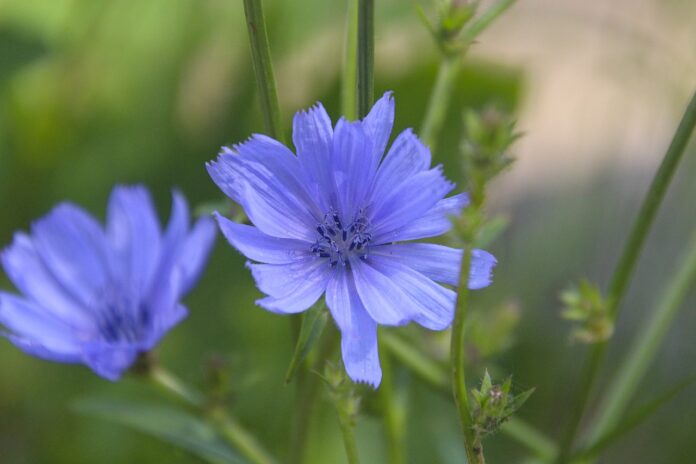Chicory, scientifically known as Cichorium intybus, is a perennial herbaceous plant that is native to Europe and is now naturalized in many parts of North America. It is easily recognizable by its vibrant blue flowers, although it can occasionally produce white or pink blooms. Chicory has a long, thick taproot and leafy stems, often growing to heights between 1 to 4 feet.
Interesting Facts About Chicory:
- Edible Plant Parts: Chicory is highly versatile, with different parts used for culinary and medicinal purposes. The leaves are commonly used in salads, especially young leaves, which have a less bitter taste. The roots, when roasted, create a caffeine-free coffee substitute, which was particularly popular during times of coffee shortages
- Ancient Use: The history of chicory stretches back to ancient Egypt. The Egyptians valued chicory as both a food source and a medicine, often using it to cleanse the liver and purify the blood. This practice was documented by early herbalists and has continued through history
- Coffee Substitute: In the 1800s, roasted chicory root became a widely-used coffee alternative, particularly in Europe and during economic hardships in the United States. Even today, it’s a traditional ingredient in New Orleans-style coffee, which blends coffee and chicory for a distinctive, rich flavor
- Belgian Endive Discovery: The origin of Belgian endive, a popular type of chicory, was serendipitous. In the 1850s, a Belgian farmer inadvertently discovered the blanching method when he stored chicory roots in a dark cellar. This technique produced pale, crisp, and slightly sweet heads, revolutionizing the way chicory was used
- Inulin Source: Chicory roots are rich in inulin, a naturally occurring prebiotic fiber. Inulin is known for supporting gut health by fostering beneficial bacteria in the digestive tract and is also used as a sweetener for low-glycemic and diabetic-friendly foods
- Wild vs. Cultivated: Wild chicory thrives along roadsides and in open fields, displaying stunning blue flowers, while cultivated varieties have been selectively bred to have larger, tender leaves or robust roots. The striking contrast between the wild and cultivated forms highlights its adaptability and wide use
- Nutrient Dense: Chicory is a nutritional powerhouse, providing vitamins K, A, and C, along with minerals like potassium and magnesium. It’s also low in calories, making it an excellent choice for people looking to enrich their diet with nutritious, leafy greens
- Radicchio Type: Radicchio, one of the well-known varieties of chicory, is easily recognizable by its red, bitter leaves. It features prominently in Italian dishes, such as risottos and grilled side dishes, and has a pleasantly spicy edge that mellows when cooked
- Chicory Tea: Chicory root is dried and steeped to make a tea that is said to detoxify the liver and aid digestion. This tea has been used for centuries as a home remedy and is sometimes consumed for its purported calming effects on the nervous system
- Livestock Forage: Chicory is not only valued by humans but also as a highly nutritious forage crop for livestock. It contains bioactive compounds that help reduce internal parasites in sheep and cattle, making it a beneficial addition to pasture mixes
- Tightly Packed Leaves: Belgian endive and other varieties with tightly packed leaves are cultivated under strict conditions. The roots are grown and then transferred to dark, temperature-controlled environments to prevent photosynthesis and produce the signature pale heads with a mildly bitter flavor
- Dandelion Family: Chicory belongs to the Asteraceae family, sharing a lineage with dandelions and sunflowers. This family connection is evident in the plant’s deep taproots and the composite structure of its blue flowers, which resemble those of dandelions
- Pest Resistance: Chicory is naturally pest-resistant, which is an advantage for organic farming. It has compounds that deter many insects and diseases, reducing the need for pesticides and making it a sustainable crop choice
- Sugarloaf Chicory: This particular variety is named for its sweet flavor and elongated, conical shape. It’s often enjoyed in salads and is one of the less bitter types of chicory, making it a favorite for raw consumption
- Italian Varieties: Varieties like Puntarelle and Catalogna are staples in Italian cuisine, commonly sautéed or served in salads. Puntarelle, in particular, is known for its crunchy texture and is often dressed in anchovy and garlic-based sauces
- Frisée Leaf Shape: The frilly leaves of Frisée chicory add both texture and visual appeal to dishes. This variety is typically used in gourmet salads, where the slightly bitter taste complements rich, savory dressings
- Cold-Hardy Plant: Chicory thrives in cooler climates and can withstand frost, which extends its growing season. It is ideal for late fall or winter harvests, making it a reliable crop in temperate regions
- Color Variety: Chicory leaves come in a spectrum of colors, from deep red to vibrant green, depending on the variety. The plant’s coloration is often tied to the growing conditions, with some types, like radicchio, requiring cool weather to achieve their signature hues
- Witloof Cultivation: Growing Witloof chicory, or Belgian endive, involves a two-step process. First, roots are cultivated in the field, then they are harvested and forced in darkness to produce the signature tight, pale heads. This labor-intensive method results in a vegetable that is highly valued in gourmet cuisine
